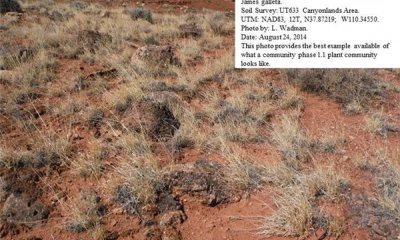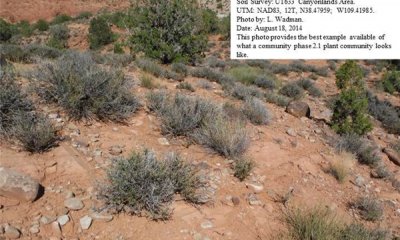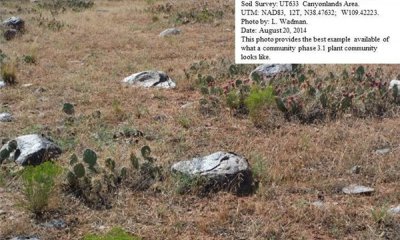
Semidesert Stony Loam (Blackbrush)
Scenario model
Current ecosystem state
Select a state
Management practices/drivers
Select a transition or restoration pathway
- Transition T1A More details
- Transition T2A More details
- Transition T2B More details
-
No transition or restoration pathway between the selected states has been described
Target ecosystem state
Select a state
Description
This reference state describes the various biotic communities that are expected to be found on this ecological site under natural conditions. This state has a well developed shrub layer with blackbrush dominating. Mormon tea and fourwing saltbush are other common shrub species. Indian ricegrass and James galleta are the dominant herbaceous species with bottlebrush squirreltail and needle-and-thread commonly occurring. Other native grasses, forbs, and shrubs will often produce a significant portion of vegetative composition in the plant community.
The reference state is self-sustaining and resistant to change due to a good natural resilience to its natural disturbances. The primary natural disturbance mechanisms are wildlife population densities which can affect the shrub layer composition, weather fluctuations, and fire period.
Definitions:
Reference State: Natural plant communities as influenced by shrub canopy density, long term weather fluctuations, and periodic fire.
Indicators: These communities are dominated by blackbrush, James galleta and Indian ricegrass. The density of the shrub canopy determines the amount and composition of the other native species present in the community.
Feedbacks: Natural fluctuations in weather patterns that allow for a self-sustaining shrub and native grass community. Prolonged drought, an increase in fire frequency, or other disturbances may allow for the establishment of invasive species.
At-risk Community Phase: All communities are at risk when native plants are stressed and conditions are created that may allow invasive plants to establish.
Trigger: The establishment of invasive plant species.
Submodel
Description
This state describes the plant communities that may or have become established on this ecological site under various successional sequences and disturbance conditions. This state typically has a shrub layer dominated by blackbrush. Mormon tea and four-wing saltbush are other common shrub species. Perennial grasses including Indian ricegrass, James galleta, needle-and-thread and other palatable grasses and forbs are much reduced in the community. Non-native species including cheatgrass, Russian thistle, redstem storksbill, various mustard species and other non-native species are now present on the site and under certain circumstances, may visually dominate the sites aspect. Utah juniper will readily invade this site if a seed source is available.
The primary disturbance mechanisms are the shrub layer density; the amount of invasive species present; weather fluctuations; and fire. The current potential state is still self-sustaining but may be losing its resistance to change due to the impact of disturbances with less resilience following those disturbances.
Definitions:
Current Potential State: Plant communities influenced by shrub canopy density, long term weather fluctuations, and periodic fire. Invasive species are present in various amounts.
Indicators: A community dominated by blackbrush, few perennial grasses and forbs present. The density of the shrub canopy determines the amount and composition of the other native and introduced grasses and forbs that may be present.
Feedbacks: Natural fluctuations in weather patterns that allow for a self sustaining shrub and native grass community. Prolonged drought, more frequent fires, and/or other disturbances that may allow for the increase of invasive species.
At-risk Community Phase: All communities are at risk when native plants are stressed and nutrients become available for invasive plants to increase.
Trigger: A reduction of perennial grass and forb species combined with an increase of invasive plant species.
Submodel
Description
The Disturbed State of this ecological site has undergone significant changes. These changes have included recent reoccurring fire and long term overuse by cattle and/or wildlife including wild horses. These disturbances have resulted in new community phases that may have permanently altered the sites original perennial vegetation. Some burned sites appear to be locked into a very short burn-cycle of approximately 5 to 15 years keeping them in a continuous herbaceous state. Prickly pear cactus and various invasive weed species dominate the sites understory.
Terminology:
Current Potential State: Plant communities influenced by events including overgrazing, burning, chaining and climatic fluctuations.
Indicators: Non-native species are now present in all plant communities.
Feedbacks: Extended drought and other disturbance that changes the ecological dynamics of the site.
At-risk Community Phase: All communities are at risk.
Trigger: Disturbance that facilitates permanent vegetative changes.
Submodel
Mechanism
This transitional pathway describes the affects of long term drought that may not allow for sufficient precipitation to support herbaceous species and/or long periods without fire. Heavy wildlife browsing can allow for non-palatable shrubs to increase. Heavy livestock grazing will reduce palatable herbaceous species. Invasive species may invade the site.
Mechanism
This transitional pathway describes the affects of reoccurring fire combined with periods of drought and poor livestock management to lock the site into an annual weed prickly pear community.
Model keys
Briefcase
Add ecological sites and Major Land Resource Areas to your briefcase by clicking on the briefcase (![]() ) icon wherever it occurs. Drag and drop items to reorder. Cookies are used to store briefcase items between browsing sessions. Because of this, the number of items that can be added to your briefcase is limited, and briefcase items added on one device and browser cannot be accessed from another device or browser. Users who do not wish to place cookies on their devices should not use the briefcase tool. Briefcase cookies serve no other purpose than described here and are deleted whenever browsing history is cleared.
) icon wherever it occurs. Drag and drop items to reorder. Cookies are used to store briefcase items between browsing sessions. Because of this, the number of items that can be added to your briefcase is limited, and briefcase items added on one device and browser cannot be accessed from another device or browser. Users who do not wish to place cookies on their devices should not use the briefcase tool. Briefcase cookies serve no other purpose than described here and are deleted whenever browsing history is cleared.
Ecological sites
Major Land Resource Areas
The Ecosystem Dynamics Interpretive Tool is an information system framework developed by the USDA-ARS Jornada Experimental Range, USDA Natural Resources Conservation Service, and New Mexico State University.










